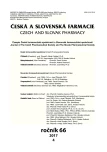Specifics of some calcium salts in intravenous therapy of hypocalcemia and their further use
Authors:
Michal Janů
Published in:
Čes. slov. Farm., 2017; 66, 160-163
Category:
Review Articles
Overview
Hypocalcemia is a serious condition which has a major impact on the transmission of nerve impulses, contraction and relaxation of muscles (including myocardial) and pathological secretion of some hormones. The basic causal treatment is the parenteral administration of calcium, namely calcium gluconate, calcium chloride or calcium gluceptate. Parenteral formulations of these compounds must meet pharmacopoeial requirements, including the aluminum content limit. Each of these molecules has its specific properties that predict their clinical use. In addition to hypocalcemia, they are used to influence a variety of other conditions, such as fluoride or oxalic acid poisoning, decreased myocardial contractility caused by overdose of calcium intake blockers or beta blockers. They are also used as part of parenteral nutrition AIO or as an ancillary treatment for acute allergic conditions, itchy dermatitis, weeping and generalized eczema, continuous renal replacement therapy, seizure convulsion, laryngospasm, bronchospasm and altered mental status. The role of calcium replacement in septic patients remains unclear and requires further study. Although it may appear that calcium chloride infusion solutions provide greater and more highly ionized amounts of calcium, gluconate salts are preferred due to considerably less irritation of the vessel wall and better compatibility with other nutrients in parenteral nutrition.
Key words:
hypocalcemia • calcium gluconate • calcium chloride • aluminum • parenteral nutrition
Sources
1. Cooper M. S., Gittoes N. J. Diagnosis and management of hypocalcemia. BMJ 2008; 336, 1298–1302.
2. Broulík P. Diferenciální diagnóza hypokalcemie. Interní Med. 2009; 11(11), 507–510.
3. Shoback D. Hypoparathyroidism. N. Engl. J. Med. 2008; 359, 391–403.
4. Minisola S., Pepe J., Piemonte S., Cipriani C. The diagnosis and management of hypercalcaemia. BMJ 2015; 350, h2723.
5. Forsythe R. M., Wessel C. B., Billiar T. R., Angus D. C., Rosengart M. R. Parenteral calcium for intensive care unit patients. Cochrane Database Syst. Rev. 2008; 4, CD006163.
6. ČL 2009, doplněk 2010–2016. Praha: Grada Publishing 2016.
7. Smith B. S., Kothari H., Hayes B. D., Tataronis G., Hudlin M. Effect of additive selection on calculated aluminum content of parenteral nutrient solutions. Am. J. Health-Syst. Pharm. 2007; 64, 730–739.
8. Huston R. K, McCulley E. A., Markell A. M., Heisel C. F., Lewallen P. K. Neonatal parenteral nutrition containing calcium chloride and sodium phosphate: mineral intake and aluminum content. ICAN Infant. Child Adolescent Nutr. 2012; 4, 137–142.
9. Poole R. L., Hintz S. R., Mackenzie N. I., Kerner J. A. Aluminum exposure from parenteral nutrition: meeting the new FDA regulation. JPEN J. Parenter. Enteral. Nutr. 2008; 32, 242–246.
10. ALS, protokol o zkoušce, FP12Q0077. Praha: OPSL VFN 2012.
11. ALS, protokol o zkoušce, FP17Q0268. Praha: OPSL VFN 2017.
12. Jones & Bartlett learning LLC. Calcium Imbalances. Chapter 6. https://www.jblearning.com/ (20. 7. 2017).
13. Jucgla A., Sais G., Curco N., Marcoval J., Moreno A., Peyri J. Calcinosis cutis following liver transplantation: a complication of intravenous calcium administration. Br. J. Dermatol. 1995; 132(2), 275–278.
14. SÚKL. Databáze léků, AISLP, SPC, http://www.sukl.cz/modules/medication/search.php (20. 7. 2017).
15. Collage R .D., Howell G. M., Zhang X., Stripay J. L., Lee J. S., Angus D. C., Rosengart M. R. Calcium supplementation during sepsis exacerbates organ failure and mortality via calcium/calmodulin-dependent protein kinase kinase signaling. Crit. Care Med. 2013; 41(11), 352–360.
16. Driscoll D. F. Stability and compatibility assessment techniques for total parenteral nutrition admixtures: Setting the bar according to pharmacopeial standards. Current Opinion. Clin. Nutr. Med. Care 2005; 8, 297–303.
17. Trissel, L. A. Handbook on Injectable Drugs. 14th ed. USA, ASHP 2007.
Labels
Pharmacy Clinical pharmacologyArticle was published in
Czech and Slovak Pharmacy

2017 Issue 4
Most read in this issue
- Possibilities of using sodium hyaluronate in pharmaceutical and medical fields
- Specifics of some calcium salts in intravenous therapy of hypocalcemia and their further use
- Synergistic effect of azole antimycotics (clotrimazole and fluconazole) and natural substances
- Cholinesterase activity assays and their use in the diagnosis of various pathological states including poisoning by neurotoxic agents
